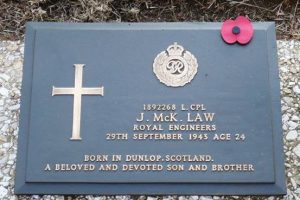Lance Corporal John McKenzie Law
Personal Details
- 1892268 Lance Corporal
- John McKenzie Law
- 1 Malaya Bomb Disposal Company
- Royal Engineers
Son of Archibald and Alexandrina Law of Dunlop, Ayrshire.
Died on the 29th September 1943. Aged 24.
Buried at Thanbyuzayat War Cemetery.
Grave B 6. M. 5.
Prisoner of the Japanese.
1 Malaya Bomb Disposal Company, was part of the Singapore Fortress. In total 42,610 members of the British Army were taken into captivity, 10, 298 died whilst in Japanese hands.
The notorious Burma-Siam railway, built by Commonwealth, Dutch and American prisoners of war, was a Japanese project driven by the need fir improved communications to support the large Japanese army in Burma. During its construction, approximately 13,000 prisoners of war died and were buried along the railway. An estimated 80,000 to 100,000 civilians also died in the course of the project, chiefly forced labour brought from Malaya and the Dutch East Indies, or conscripted inSiam (Thailand) and Burma (Myanmar). Two forced labour forces, one based in Siam and the other in Burma worked from opposite ends towards the centre. The Japanese aimed at completing the railway in 14 months and work began in October 1942. The line, 424 kilometres long, was completed by December 1943. The graves of those who died during the construction and maintenance of the Burma-Siam railway (except for the Americans, whose remains were repatriated) were transferred from camp burial grounds and isolated sites along the railway into three cemeteries at Chungkai and Kanchanaburi in Thailand and Thanbyuzayat in Burma. Thanbyuzayat became a prisoner of war administration headquarters and base camp in September 1942 and in January 1943 a base hospital was organised for the sick. The camp was close to a railway marshalling yard and workshops, heavy casualties were sustained among the prisoners during Allied bombing raids in March and June 1943. The camp was then evacuated and the prisoners, including the sick, were marched to camps further along the line where camp hospitals were set up. For some time, however, Thanbyuzayat continued to be used as a reception centre for the groups of prisoners arriving at frequent intervals to reinforce the parties working on the line up to the Burma-Siam border. Thanbyuzayat War Cemetery was created by the Army Graves Srvice who transferred to it all graves along the northern section of the railway, between Moulmein and Nieke.
Details taken from the Commonwealth War Graves Commission web site.
2 Comments
Submit a Comment

About Us
The aim of the site is to provide a meeting point for all those involved in Explosive Ordnance Disposal (EOD) or Search whether serving or ex-serving members of the Royal Engineers and a source of material for those researching the work of the Royal Engineers or family history
Links
Donate
If you wish to donate to the running of the branch, please use the button below.
Terms & Conditions | Privacy Policy | Copyright © 2023 The Royal Engineers Association.
All rights reserved.



RE Ernest Barker POW, remained (volunteered?) after war ended, to disinter comrades who had been buried alongside the railway. He had a rough map made by POW’s He and 4 others buried them in an area which became Thanbyuzayat Cemetery. Have you any further information?
Unable to find any record of their names Photos etc.
Ernest Barker was “Appointed as an Inspector for Burma (South East Asia District) on 10th November 1947. Left the Commission on 9 February 1951. Congratulated on the condition of the cemetery by Sir Hugh Rance.
On letter: No.927736 E.Barker.CPL.RE c/o D.A.D.G.R & E. HQ 14th ARMY, S.E.A.C. (4th Jan. 1943)
No further information to submit.
Thank you.